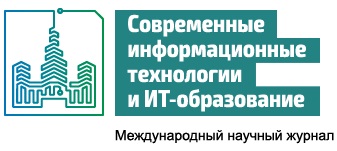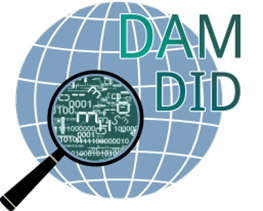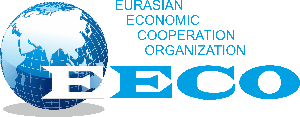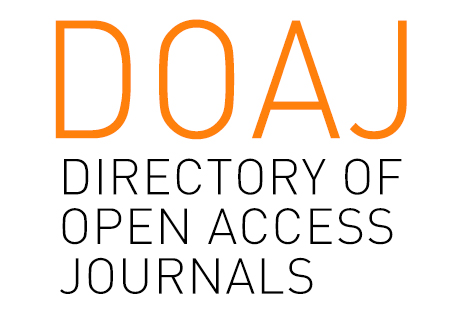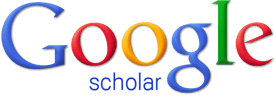Имитационная модель спуска симметричного авторотирующего тела в воздушной среде
Аннотация
В работе построена математическая модель тела сложной конфигурации, состоящего из стержня и двух прямоугольных пластинок, ортогональных к стержню, которое представляет собой рабочий элемент ветротурбины Дарье. Тело совершает плоскопараллельное снижение под действием силы тяжести и аэродинамических сил. Аэродинамические силы, приложенные к пластинкам, приняты в соответствии с эмпирической теорией стационарного обтекания плоской пластины. Исследуется вопрос о существовании различных стационарных режимов спуска и их устойчивости. Сначала рассматриваются простейшие стационарные режимы, при которых тело движется поступательно. Указаны наиболее характерные простейшие режимы поступательного движения. Найден режим планирования под углом восемьдесят семь градусов. Наибольший интерес в работе представляет режим авторотации, при котором тело быстро вращается и осуществляет снижение по вертикали или наклонной прямой подобно свободно вращающемуся несущему винту. При помощи метода осреднения получены оценки средней угловой скорости, средней скорости центра масс и среднего угла планирования тела в режиме авторотации; доказано, что режим авторотации является притягивающим. Показано, что спуск в режиме авторотации происходит с наименьшей скоростью по сравнению с другими режимами, что позволяет применять эту конструкцию в качестве системы спуска или аэродинамического тормозного устройства, либо как систему планирования. Численно решены уравнения равновесия и построены зависимости угла планирования от установочного угла и вертикальной проекции скорости от установочного угла. Написаны программы, в которых проводится численное интегрирование уравнений движения рассматриваемого тела и результаты численного интегрирования сравниваются с полученными теоретическими оценками для оценки точности рассматриваемых методов.
Литература
[2] Belyakov D.V. Development and Features of Mathematical Model of Movement Asymmetrical Autorotating Bodies in Quasi-static to Environment. Mekhatronika, Avtomatizatsiya, Upravlenie. 2007; 11:20- 24. Available at: https://elibrary.ru/item.asp?id=9609383 (accessed 02.06.2019). (In Russ., abstract in Eng.)
[3] Samsonov V.A., Belyakov D.V., Cheburakhin I.F. Vertical reduction of a heavy symmetric autorotising body” in a resisting medium. Nauchnye Trudy MATI. 2005; 9(81):145-150. (In Russ.)
[4] Samsonov V.A., Belyakov D.V. Mathematical modeling of the movement of a symmetric autorotising body, promoted to a high angular velocity, in air. Nauchnye Trudy MATI. 2006; 10(82):196-200. (In Russ.)
[5] Belyakov D.V., Samsonov V.A. Assessment of the possibilities of a new type of object rotating the airborne one. In: Medvedeva A.K. (ed). Proceedings of the XXVI Academic Readings on Astronautics. 2002, pp. 100. (In Russ.)
[6] Belyakov D.V. Mathematical modeling of the motion of a rotating object descending in the air. In: Proceedings of the Fifth International Aerospace Congress IAC-06. Dedicated to the 20th nniversary of the launch of the MIR space station. M., 2006, p. 62-63. (In Russ.)
[7] Belyakov D.V. Mathematical model of an asymmetric autorotising body in a resisting environment. In: Proceedings of the International Youth Scientific XXXIII Gagarin Science Conference. M., 2007, pp. 27-28. (In Russ.)
[8] Belyakov D.V. Mathematical modeling of the motion of a rotating object descending in the air. In: Proceedings of the Fifth International Aerospace Congress IAC-06. Dedicated to the 20th Anniversary of the launch of the MIR Space Station. M., 2006. (In Russ.)
[9] Belyakov D.V. Promising technologies for creating a system of safe descent in the air. In: Proceedings of the All-Russian Scientific and Technical Conference "New materials and technologies" - NTM-2008. M., SEI HPE MATI – RGTU, 2008, pp. 117. (In Russ.)
[10] Lokshin B.Ya. , Privalov V.A., Samsonov V.A. Introduction to the problem of the motion of a point and a body in a resisting medium. M., MSU, 1986. (In Russ.)
[11] Parshin D.E. Qualitative analysis in the problem of the motion of an aerodynamic pendulum: dis. ... Ph.D. (Phys.-Math.). M.: MSU, 1993. (In Russ.)
[12] Lokshin B. Ya., Privalov V. A., Samsonov V. A. Qualitative analysis in the problem of the motion of an aerodynamic pendulum. In: Proceedings of the Sixth All-Union Congress on Theoretical and Applied Mechanics. Tashkent, 1986. (In Russ.)
[13] Tabachnikov V.G. Stationary characteristics of the wings at low speeds over the entire range of angles of attack. TsAGI Science Journal. 1974; 1621:79-93. (In Russ.)
[14] Strickland J. H., Smith T., Sun K. A Vortex Model of the Darrieus Turbine: An Analytical and Experimental Study. Journal of Fluids Engineering. 1979; 101(4):500-505. (In Eng.) DOI: 10.1115/1.3449018
[15] Sholomovich G.I., Karlikov V.P., Zverev O.V. A study on the optimization of orthogonal energy units for using the energy of air and water currents. Evaluation of the effect of curvature and inhomogeneity of the flow on the aerodynamic characteristics of the profile. M., 1990. (In Russ.)
[16] Paraschivoiu J., Delclaux F. Double Multiple Stremeamtube model with Recent Improvements. Journal of Energy. 2012; 7(3):250-255. (In Eng.) DOI: 10.2514/3.48077
[17] Vittecoq P., Laneville A. The aerodynamic forses for a Darrieus rotor with straight blades: Wind Tunnel measurement. Journal of Wind Engineering and Industrial Aerodynamics. 1983; 15(1-3):381-388. (In Eng.) DOI: 10.1016/0167-6105(83)90207-6
[18] Parashivoiu I. Aerodynamics Loads and Performance of the Darrieus Rotor. Journal of Energy. 1982; 6(6):406-412. (In Eng.) DOI: 10.2514/3.62621
[19] Zhuravlev V.F., Klimov D.M. Prikladnye metody v teorii kolebanij [Applied methods in the theory of oscillations]. Nauka, Moscow, 1988. (In Russ.)
[20] Malkin I.G. Teoriya ustojchivosti dvizheniya [The theory of the stability of motion]. Nauka, Moscow, 1966. (In Russ.)
[21] Samsonov V.A., Sumin T.S. Stability of equilibrium state of a mechanical system with two degrees of freedom. Vestnik Moskovskogo Universiteta. Seriya 1. Matematika. Mekhanika. 2004; 4:60-62. Available at: http://www.mathnet.ru/php/archive.phtml?wshow=paper&jrnid=vmumm&paperid=3669&option_lang=rus (accessed 02.06.2019). (In Russ., abstract in Eng.)
[22] Lokshin B.Ya., Samsonov V.A. On heuristic model of aerodynamical pendulum. Fundamentalnaya i prikladnaya matematika = Fundamental and Applied Mathematics. 1998; 4(3):1047-1061. Available at: http://www.mathnet.ru/php/archive.phtml?wshow=paper&jrnid=fpm&paperid=341&option_lang=rus (accessed 02.06.2019). (In Russ., abstract in Eng.)
[23] Belyakov D.V. Mathematical modeling of the motion axisymmetric autorotating bodies in quasistatic to ambience. International Journal of Open Information Technologies. 2015; 3(3):7-16. Available at: https://elibrary.ru/item.asp?id=22993754 (accessed 02.06.2019). (In Russ., abstract in Eng.)
[24] Belyakov D.V. The problem of self-oscillations of the plate in the flow of the medium. Sovremennye informacionnye tehnologii i IT-obrazovanie = Modern Information Technologies and IT-Education. 2015; 11(2):552-555. Available at: https://elibrary.ru/item.asp?id=26167543 (accessed 02.06.2019). (In Russ.)

Это произведение доступно по лицензии Creative Commons «Attribution» («Атрибуция») 4.0 Всемирная.
Редакционная политика журнала основывается на традиционных этических принципах российской научной периодики и строится с учетом этических норм работы редакторов и издателей, закрепленных в Кодексе поведения и руководящих принципах наилучшей практики для редактора журнала (Code of Conduct and Best Practice Guidelines for Journal Editors) и Кодексе поведения для издателя журнала (Code of Conduct for Journal Publishers), разработанных Комитетом по публикационной этике - Committee on Publication Ethics (COPE). В процессе издательской деятельности редколлегия журнала руководствуется международными правилами охраны авторского права, нормами действующего законодательства РФ, международными издательскими стандартами и обязательной ссылке на первоисточник.
Журнал позволяет авторам сохранять авторское право без ограничений. Журнал позволяет авторам сохранить права на публикацию без ограничений.
Издательская политика в области авторского права и архивирования определяются «зеленым цветом» в базе данных SHERPA/RoMEO.
Все статьи распространяются на условиях лицензии Creative Commons «Attribution» («Атрибуция») 4.0 Всемирная, которая позволяет другим использовать, распространять, дополнять эту работу с обязательной ссылкой на оригинальную работу и публикацию в этом журналe.
